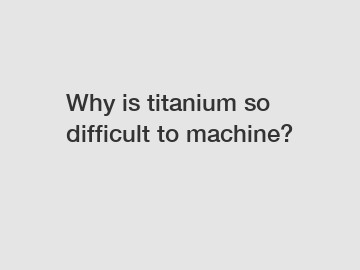Why is titanium so difficult to machine?
Titanium is a popular material in various industries due to its exceptional strength-to-weight ratio, corrosion resistance, and biocompatibility. However, machining titanium can be a challenging task for many manufacturers. The unique properties of titanium make it difficult to machine compared to other metals like steel or aluminum. In this article, we will explore the reasons why titanium is so difficult to machine.
## Hardness and Strength.
Titanium is known for its high strength and hardness, which can make it challenging to cut and shape. The hardness of titanium is comparable to that of some of the hardest materials, such as hardened tool steel. This means that traditional cutting tools used for machining other metals may wear out quickly when cutting titanium. Manufacturers need to use specialized cutting tools that can withstand the hardness of titanium and maintain their sharpness for longer periods.

## High Specific Cutting Force.
Another reason why titanium is difficult to machine is its high specific cutting force. Specific cutting force refers to the force required to remove a unit volume of material. Due to its high strength and low thermal conductivity, titanium requires more force to cut compared to other metals. This high specific cutting force can lead to tool wear, increased machining time, and higher energy consumption. Manufacturers need to carefully plan their machining processes to account for the high specific cutting force of titanium.
## Low Thermal Conductivity.
Titanium has a low thermal conductivity, which means that it is not able to dissipate heat quickly during machining. As a result, the temperature at the cutting edge of the tool can rise rapidly, leading to tool wear, built-up edge formation, and poor surface finish. To overcome this challenge, manufacturers often use cutting fluids or cryogenic cooling techniques to help dissipate heat and improve the machining process. Proper cooling and lubrication are crucial when machining titanium to prevent damage to the cutting tool and workpiece.
## Chemical Reactivity.
Titanium is highly reactive with oxygen, nitrogen, and other gases at high temperatures. During machining, the cutting tool generates heat, which can cause the formation of titanium oxides and nitrides on the surface of the workpiece. These hard and brittle compounds can accelerate tool wear and reduce the quality of the machined surface. To minimize chemical reactions during machining, manufacturers often use high-speed cutting tools, controlled atmospheres, or inert gas environments to protect the workpiece from oxidation and contamination.
## Conclusion.
In conclusion, titanium is difficult to machine due to its high strength, hardness, specific cutting force, low thermal conductivity, and chemical reactivity. Manufacturers face challenges when machining titanium, such as tool wear, longer machining times, and poor surface finish. Despite these challenges, titanium remains a popular choice in industries such as aerospace, medical, and automotive due to its unique properties. By using specialized cutting tools, proper cooling and lubrication, and controlled machining environments, manufacturers can overcome the difficulties associated with machining titanium.
If you are looking for more information on machining titanium or have any questions, feel free to contact us. We are here to help with your machining needs.
For more Tungsten Electrode for Stainless Steel, Hard Alloy Ball, Niobium Rodinformation, please contact us. We will provide professional answers.

Comments
0